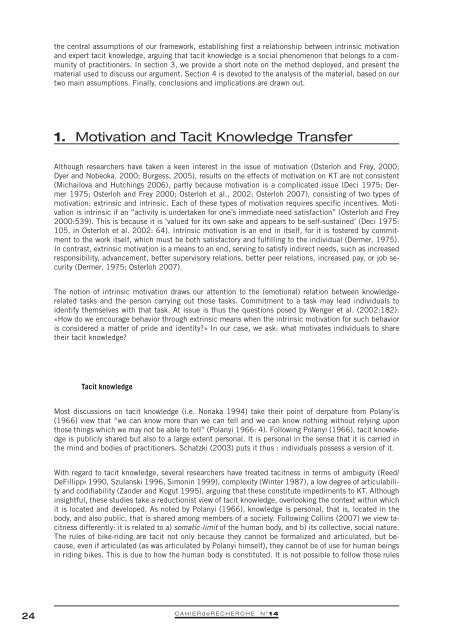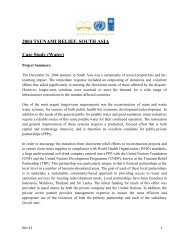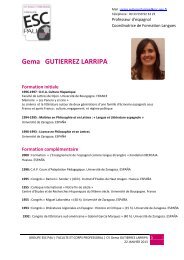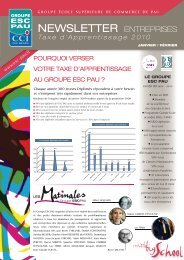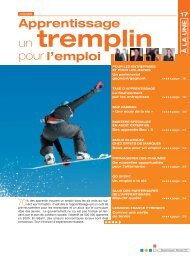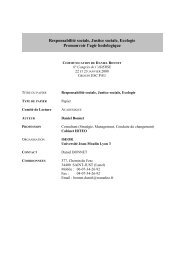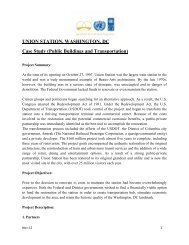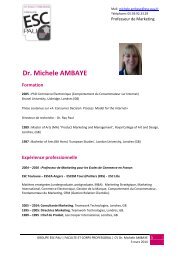IntroductionAlthough the importance of knowledge transfer (KT) is wi<strong>de</strong>ly recognized, the process of transferringknowledge from one individual to another still remains a challenge for the majority of organizations(Szulanski, 1996; Burgess, 2005; Hurt and Hurt, 2005; Teigland and Wasko 2009). Research into intra-organizationalknowledge transfer has i<strong>de</strong>ntified four contingencies that affect the knowledge transferprocess: the nature of knowledge to be transferred, the features of the sen<strong>de</strong>rs, those of the recipientsand the nature of the relation between sen<strong>de</strong>rs and receivers. The characteristics of knowledge impactthe transfer outcome such that tacit (Polanyi 1967), sticky knowledge (Szulanski 1996) is more difficultto transfer (Reed and DeFilippi 1990; Zan<strong>de</strong>r and Kogut 1995; Simonin 1999; Ipe 2003; Teigland andWasco 2009). With regard to the characteristics of the sen<strong>de</strong>rs, researchers contend that motivation toshare knowledge is a facilitator (Szulanski 1996; Argote and Ingram 2000; Teigland and Wasko 2009).The receiver’s absorptive capacity (Zahra and George 2002) as well their retentive capacity also play animportant role in the KT process. Finally, the social and contextual relationships between the knowledgeentities the KT process (Szulanski 1996; Eisenhardt and Santos 2002; Husted and Michailova 2002).Relations of trust (Levin and Cross, 2004) and the strength of ties (Hansen, 1999) between knowledgeentities, organizational forms (Osterloh and Frey, 2000), and individuals’ status (Thomas-Hunt et al.2003) impact the KT outcome.Although these four contingencies are significant for our un<strong>de</strong>rstanding of the transfer process, researchersseem to overlook the importance of the relationship between tacit knowledge and the kind of motivationthat seems to be best suited to facilitate its transfer. Whereas tacitness of knowledge is usuallyregar<strong>de</strong>d as ”a natural impediment to the successful sharing of knowledge between individuals in organizations”(Ipe 2003: 344), as inherently difficult to transfer (Tissen, Andriessen, & Deprez 1998) we wishto suggest that tacit knowledge is usually linked to intrinsic motivation and that this relationship affectsthe outcome of the transfer process. Motivation is not only a psychological state of an individual; nor istacit knowledge solely a feature of knowledge. Motivation and tacit knowledge co-configure each otherand the strength of this relationship impacts the KT outcome. To illustrate our argument, we have studieda group of <strong>de</strong>parting experts within a large oil company focusing on their efforts to transfer their hard-wonexpertise knowledge to newly-recruited engineers.Our suggestion complements the four-fold mo<strong>de</strong>l of knowledge transfer by emphasizing the relationshipbetween intrinsic motivation, tacit knowledge and its transfer. Whereas most previous research posits thattacit knowledge (as a feature of knowledge) is a barrier to its transfer, we contend that sharing and transferringtacit knowledge are supported intrinsic motivation which facilitates the transfer process. Becausetacit knowledge, such as expertise, requires long-term commitment to one’s area of expertise and years ofexperience in that specific area, it is more likely that experts are intrinsically-driven to acquire and refineit, and because it is socially constructed, transferring and sharing it with others is the very process ofits production. Accordingly, the relation between knowledge and its possessor constitutes a social bondthat is strengthened through social interactions. These consi<strong>de</strong>rations will have implications for HRMpractices, such as training and reward systems. Finally, the paper questions the economic view that tacit,expert knowledge can be treated as an ‘intellectual good’ which can be possessed by individuals and‘tra<strong>de</strong>d’ (Osterloh et al., 2002). Tacit knowledge involves a practice, a set of know-how, which belongsto a community of practitioners (Lave and Wenger 1991) because it pre-exists individuals. Individualsare only carriers of that practice (Schatzki 2003). This social dimension of tacit knowledge questionsthe economic view of knowledge as abankable and tradable good. This question is significant as it drawsattention to a more complex logic that <strong>de</strong>fines the organizational behaviour. Ultimately, we want to lendsupport to the theory that tangible rewards alone are not sufficient to motivate knowledge sharing amongcertain groups, such as professionals who participate in knowledge-sharing activities because of the intrinsicreward that comes from the work itself (Tissen et al 1998).The remain<strong>de</strong>r of the paper unfolds as follows : the next section review the relevant theories in the literature,focusing on the intersection between knowledge, intrinsic motivation and KT. Section 2 <strong>de</strong>velopsCAHIER<strong>de</strong>RECHERCHE N°1423
the central assumptions of our framework, establishing first a relationship between intrinsic motivationand expert tacit knowledge, arguing that tacit knowledge is a social phenomenon that belongs to a communityof practitioners. In section 3, we provi<strong>de</strong> a short note on the method <strong>de</strong>ployed, and present thematerial used to discuss our argument. Section 4 is <strong>de</strong>voted to the analysis of the material, based on ourtwo main assumptions. Finally, conclusions and implications are drawn out.1. Motivation and Tacit Knowledge TransferAlthough researchers have taken a keen interest in the issue of motivation (Osterloh and Frey, 2000;Dyer and Nobeoka, 2000; Burgess, 2005), results on the effects of motivation on KT are not consistent(Michailova and Hutchings 2006), partly because motivation is a complicated issue (Deci 1975; Dermer1975; Osterloh and Frey 2000; Osterloh et al., 2002; Osterloh 2007), consisting of two types ofmotivation: extrinsic and intrinsic. Each of these types of motivation requires specific incentives. Motivationis intrinsic if an “activity is un<strong>de</strong>rtaken for one’s immediate need satisfaction” (Osterloh and Frey2000:539). This is because it is ‘valued for its own sake and appears to be self-sustained’ (Deci 1975:105, in Osterloh et al. 2002: 64). Intrinsic motivation is an end in itself, for it is fostered by commitmentto the work itself, which must be both satisfactory and fulfilling to the individual (Dermer, 1975).In contrast, extrinsic motivation is a means to an end, serving to satisfy indirect needs, such as increasedresponsibility, advancement, better supervisory relations, better peer relations, increased pay, or job security(Dermer, 1975; Osterloh 2007).The notion of intrinsic motivation draws our attention to the (emotional) relation between knowledgerelatedtasks and the person carrying out those tasks. Commitment to a task may lead individuals toi<strong>de</strong>ntify themselves with that task. At issue is thus the questions posed by Wenger et al. (2002:182):«How do we encourage behavior through extrinsic means when the intrinsic motivation for such behavioris consi<strong>de</strong>red a matter of pri<strong>de</strong> and i<strong>de</strong>ntity?» In our case, we ask: what motivates individuals to sharetheir tacit knowledge?Tacit knowledgeMost discussions on tacit knowledge (i.e. Nonaka 1994) take their point of <strong>de</strong>rpature from Polany’is(1966) view that “we can know more than we can tell and we can know nothing without relying uponthose things which we may not be able to tell” (Polanyi 1966: 4). Following Polanyi (1966), tacit knowledgeis publicly shared but also to a large extent personal. It is personal in the sense that it is carried inthe mind and bodies of practitioners. Schatzki (2003) puts it thus : individuals possess a version of it.With regard to tacit knowledge, several researchers have treated tacitness in terms of ambiguity (Reed/DeFillippi 1990, Szulanski 1996, Simonin 1999), complexity (Winter 1987), a low <strong>de</strong>gree of articulabilityand codifiability (Zan<strong>de</strong>r and Kogut 1995), arguing that these constitute impediments to KT. Althoughinsightful, these studies take a reductionist view of tacit knowledge, overlooking the context within whichit is located and <strong>de</strong>veloped. As noted by Polanyi (1966), knowledge is personal, that is, located in thebody, and also public, that is shared among members of a society. Following Collins (2007) we view tacitnessdifferently: it is related to a) somatic-limit of the human body, and b) its collective, social nature.The rules of bike-riding are tacit not only because they cannot be formalized and articulated, but because,even if articulated (as was articulated by Polanyi himself), they cannot be of use for human beingsin riding bikes. This is due to how the human body is constituted. It is not possible to follow those rules24CAHIER<strong>de</strong>RECHERCHE N°14
- Page 1 and 2: CAHIERdeRECHERCHE N°14Institut de
- Page 4: SommaireComment classer les actionn
- Page 7 and 8: RésuméA l’origine, la théorie
- Page 9 and 10: influence via un contrôle externe
- Page 12 and 13: La très grande richesse des travau
- Page 14 and 15: a prévalu pendant de nombreuses an
- Page 16 and 17: Lorsque l’actionnariat a majorita
- Page 18 and 19: ConclusionAinsi, il existe différe
- Page 20 and 21: Huynh, Q. T. (2009), L’influence
- Page 22 and 23: Intrinsic Motivation,Tacit Knowledg
- Page 26 and 27: to direct the ability to balance th
- Page 28 and 29: The empirical material is elicited
- Page 30 and 31: on after I am gone. It is of no use
- Page 32 and 33: ReferencesAnderson JR (1982), “Ac
- Page 34 and 35: CAHIERdeRECHERCHE N°1433
- Page 36 and 37: University Corporate Governancein t
- Page 38 and 39: of expertise, workload, unpaid time
- Page 40 and 41: 3. Scenario PlanningUncertainty is
- Page 42 and 43: 6. Risk GovernanceRisk governance i
- Page 44 and 45: ReferencesBaird, J. (2007) ‘Takin
- Page 46 and 47: CAHIERdeRECHERCHE N°1445
- Page 48 and 49: Une analyse de la gestionde la perf
- Page 50 and 51: I. Les outils de gestion de la perf
- Page 52 and 53: définissant les finalités des act
- Page 54 and 55: Pour trois-quarts des collectivité
- Page 56 and 57: Au-delà de leur relative nouveaut
- Page 58 and 59: 2. Une mise en œuvre opérationnel
- Page 60 and 61: Or, une démarche de performance se
- Page 62 and 63: 3. L’adaptation du système local
- Page 64 and 65: esponsabilisation et d’évaluatio
- Page 66 and 67: I. NONAKA, “A dynamic theory of o
- Page 68: PROGRAMME GRANDE ÉCOLE, GRADE MAST


